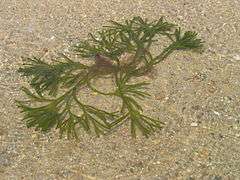Bryopsidales
| Bryopsidales | |
|---|---|
 | |
| Dead man's fingers (Codium fragile) | |
| Scientific classification | |
| Domain: | Eukaryota |
| Kingdom: | Viridiplantae |
| Division: | Chlorophyta |
| Class: | Bryopsidophyceae |
| Order: | Bryopsidales J.H. Schaffner |
| Families[1] | |
| Synonyms | |
| |
Bryopsidales is an order of green algae, in the class Bryopsidophyceae.[1]
Characteristics
The thallus is filamentous and much branched and may be packed into a mass. It is coenocytic, having multi-nucleate cells consisting of cytoplasm contained within a cylindrical cell wall. There are no septae and the many discoid chloroplasts, nuclei and other organelles are free to move through the organism. The whole organism may consist of a single cell and in the genus Caulerpa this may be several metres across. In the genus Halimeda, whole seabed meadows may consist of an individual, single-celled organism connected by filamentous threads running through the substrate.
Reproduction
Propagation is normally vegetative from small fragments which grow into new individuals. Under certain conditions sexual reproduction occurs in a process called holocarpy. Almost all of the cytoplasm in the thallus is converted into biflagellate gametes, which are discharged into the sea through papillae. After fertilisation, the zygote becomes a protonema and this in turn develops into a new thallus.[2][3]
References
- 1 2 Guiry, M.D. & Guiry, G.M. (2007). "Order: Bryopsidales taxonomy browser". AlgaeBase version 4.2 World-wide electronic publication, National University of Ireland, Galway. Retrieved 2007-09-23.
- ↑ The Cell Biology of the Bryopsidales Retrieved 2011-08-22.
- ↑ Overview of the Genus Caulerpa Proceedings of the International Caulerpa taxifolia Conference, 2002.
External links
Scientific references
- PubMed references for Bryopsidales
- PubMed Central references for Bryopsidales
- Google Scholar references for Bryopsidales
Scientific databases
- NCBI taxonomy page for Bryopsidales
- Search Tree of Life taxonomy pages for Bryopsidales
- Search Species2000 page for Bryopsidales